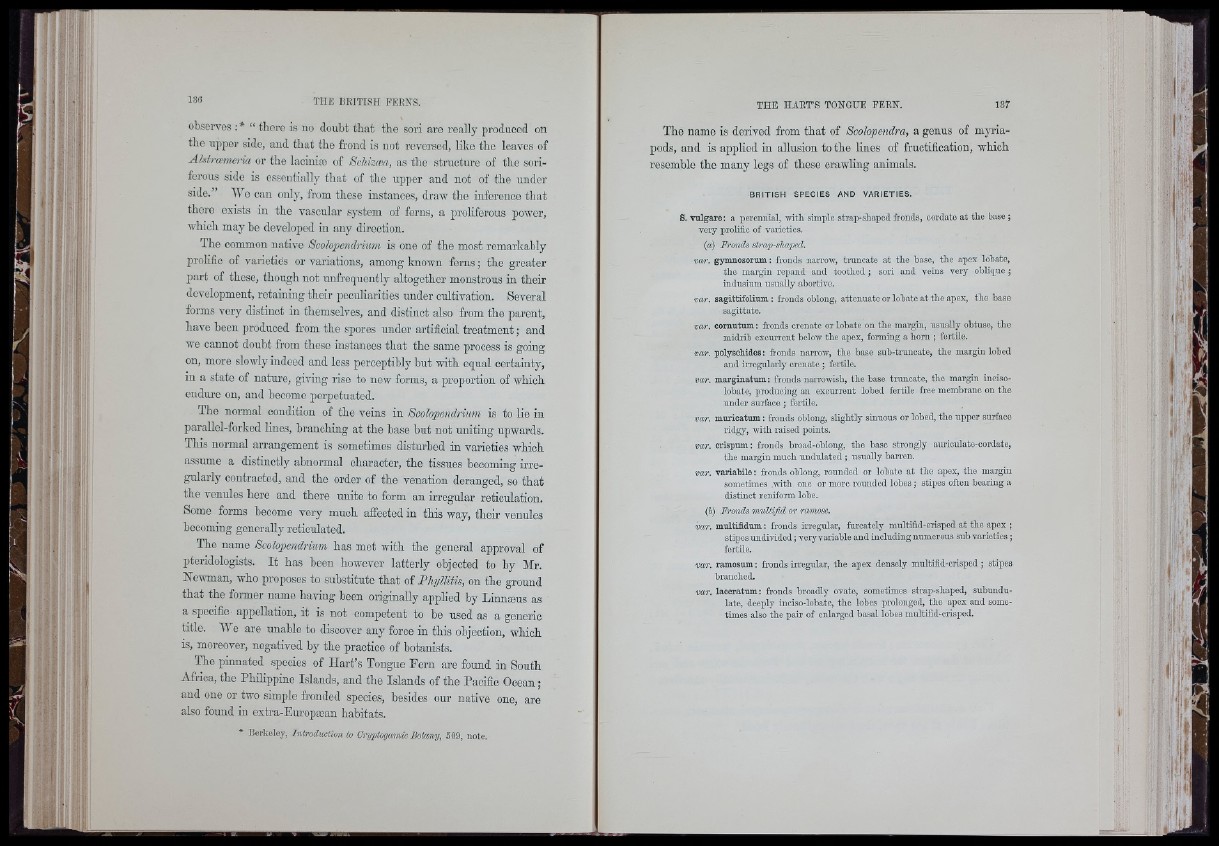
„■■■
I,
observes :* “ there is no (iouht that tho sori are really produced on
the upper side, and that the frond is not revcrsod, like tho leaves of
Ahfroemcna or tho laoiniæ of Schisæa, as the structure of the sori-
ferous side is essentially that of the upper and not of the under
side.” Wo can only, from these instances, draw the inforonoe that
there exists in tho vascular system of ferns, a proliferous power,
which may be developed in any direction.
The common native Scolopendrmm is one of the most remarkably
prolific of varieties or variations, among known ferns ; the greater
part of these, though not unfrcijuontly altogether monstrous in thoir
development, retaining their peculiarities under cultivation. Several
forms very distinct in themselves, and distinct also from the parent,
have been produced from the spores under artificial treatment ; and
we cannot doubt from these instances that the same process is going
on, more slowly indeed and less perooptihly but with equal certainty,
in a state of nature, giving rise to new forms, a proportion of which
endure on, and become perpetuated.
The normal condition of tho veins in Scolopendrium is to lie in
parallel-forked lines, branching at the base hut not uniting upwards.
This normal arrangement is sometimes disturbed in varieties which
assume a distinctly abnormal character, the tissues becoming irregularly
contracted, and the order of the venation deranged, so that
the venules hero and there unite to form an irregular reticulation.
Some forms become very much affected in this way, their venules
becoming generally reticulated.
The name Scolopendrium has met with the general approval of
pteridologists. It has been however latterly objected to by Mr.
Newman, who proposes to substitute that of Phyllitis, on the ground
that the former name having been originally applied by Linnoeus as
a specific- appellation, it is not competent to be used as a generic
title. We are unable to discover any force in this objection, which
is, moreover, negatived by the practice of botanists.
The pinnated species of Hart’s Tongue Fern are found in South
Africa, the Philippine Islands, and the Islands of the Pacifie Ocean ;
and one or two simple frondcd species, besides our native one, are
also found in extra-Europæan habitats.
* Berkeley, Introduction to Cnjptogmnic Botanxj, 509, note.
The name is derived from that of Scolopendra, a gonus of myriapods,
and is applied in allusion to the lines of fructification, which
resemble tho many legs of these crawling animals.
BRITISH SPECIES AND VARIETIES.
S. vulga re: a perennial, witli simple strap-skaped fronds, cordate a t tlie base ;
v eiy prolific of varieties.
(a) Fronds sircLp-sliape.d.
var. gynmosorum: fronds narrow, tran c a te a t tlio base, th e apex lohate,
th e margin repand and toothed ; sori and veins very oblique ;
indusium usually abortive.
var. sagittifolium ; fronds oblong, attenuate or lobate a t th e apex, th e base
sagittate.
var. cornutum.; fronds crenate or lobate on th e margin, usually obtuse, th e
midrib excurrent below th e apex, fom in g a ho rn ; fertile.
var. polyschides: fronds narrow, th e base sub-truncate, th e margin lobed
and irregidarly crenate ; fertile.
var. ma rg inatum; fronds narrowish, th e base truncate, tlie margin inciso-
lobate, producing an excurreiit lobed fertile free membrane on th e
u n d er surface ; fertile.
var. m u ric a tum : fronds oblong, slightly sinuous or lobed, th e upper surface
ridgy, with raised points.
var. crispum: fronds broad-oblong, th e base strongly auricnlate-cordate,
th e margin much undulated ; usually barren.
var. v a riab ile : fronds oblong, rounded or lobate a t th e apex, th e margin
sometimes .with one or more rounded lobes ; stqies often bearing a
d istin ct reniform lobe.
(5) Fronds muUifid or ramose,
var. multifidum: fronds irregular, furcately multifid-crisped a t th e apex ;
stipes undivided; very variable and including numerous su b v a rie tie s;
fertile.
var. ramosum: fronds irregular, th e apex densely multifid-crisped; stipes
branched.
var. laceratum: fronds broadly ovate, sometimes strap-shaped, subundn-
late, deeply inciso-lobate, th e lobes prolonged, th e apex and sometimes
also th e p a ir of enlarged basal lobes multifid-crisped.
■:'0
"■'I:
' ?
>f I
r i
i - I
'■ri